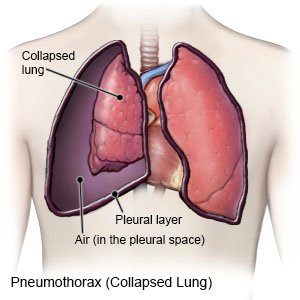Spontaneous Pneumothorax in Children
Medically reviewed by Drugs.com. Last updated on Sep 23, 2025.
AMBULATORY CARE:
A spontaneous pneumothorax
is a collapsed lung. Part or all of the lung may collapse. Air collects in the pleural space (the space between the lungs and chest wall). The trapped air prevents your child's lung from filling, and the lung collapses. A primary spontaneous pneumothorax occurs in a person with no known lung problems. A secondary spontaneous pneumothorax occurs in a person who has a known lung disease or medical condition. A spontaneous pneumothorax can happen in one or both lungs.
 |
Common signs and symptoms include the following:
- Chest pain that happens suddenly, both when your child is at rest and is mildly active
- Shortness of breath, fast breathing, or a cough
- Chest movement that is not even when your child breathes
- A fast heartbeat
- Blue skin around the mouth or fingertips
Call your local emergency number (911 in the US) if:
- Your child has new or increased shortness of breath or chest pain.
- Your child's throat or the front of his or her neck is pushed to one side.
- Your child is sweating and feels like he or she is going to pass out.
- Your child's fingernails, toenails, or lips begin to turn blue.
- Your child has trouble thinking clearly.
Call your child's doctor or pulmonologist if:
- Your child has a fever.
- You hear a crackling noise or feel popping when you touch your child's skin.
- You have questions or concerns about your child's condition or care.
Treatment
will depend on the size of your child's pneumothorax. If the pneumothorax is small, it may get better on its own. The goal of treatment is to remove the air from your child's pleural space. When your child's lung is able to fill with air, he or she will be able to breathe easier. Your child may need any of the following:
- Bed rest may be recommended if your child is healthy and has a small pneumothorax. Your child's healthcare provider will tell you how much rest your child needs each day, and how long to continue.
- Extra oxygen may be given if your child's oxygen level is too low. Oxygen may help the pneumothorax get better faster.
- Antibiotics may be given to prevent or treat a bacterial infection.
- Prescription pain medicine may be given. Ask your child's healthcare provider how to give this medicine safely. Some prescription pain medicines contain acetaminophen. Do not give your child other medicines that contain acetaminophen without talking to a healthcare provider. Too much acetaminophen may cause liver damage. Prescription pain medicine may cause constipation. Ask your child's provider how to prevent or treat constipation.
- Air removal may be done through a needle or a chest tube. A chest tube is attached to a container to remove air and collect any blood or fluid.
- Pleurodesis is a procedure used to irritate the walls of your child's pleural space. This causes the walls to close so air can no longer be trapped.
- Surgery may be used to repair your child's lung.
Safety precautions:
A change of pressure could cause another pneumothorax. Follow these and other safety precautions from your child's healthcare provider:
- Do not smoke near your child. Nicotine and other chemicals in cigarettes and cigars can increase your child's risk for another pneumothorax. Talk to your adolescent about not smoking. Ask your healthcare provider for information if you or your adolescent currently smokes and needs help to quit. E-cigarettes and smokeless tobacco still contain nicotine. Talk to a healthcare provider before you use these products.
- Do not let your child dive under water or climb to high altitudes.
- Do not let your child fly if he or she has an untreated or recurring pneumothorax. Your child's provider will tell you if it is okay for your child to fly.
- Do not let your child play sports until his or her provider says it is okay.
Follow up with your child's doctor or pulmonologist as directed:
Your child may need to return for more chest x-rays. Write down your questions so you remember to ask them during your visits.
© Copyright Merative 2025 Information is for End User's use only and may not be sold, redistributed or otherwise used for commercial purposes.
The above information is an educational aid only. It is not intended as medical advice for individual conditions or treatments. Talk to your doctor, nurse or pharmacist before following any medical regimen to see if it is safe and effective for you.
Further information
Always consult your healthcare provider to ensure the information displayed on this page applies to your personal circumstances.
